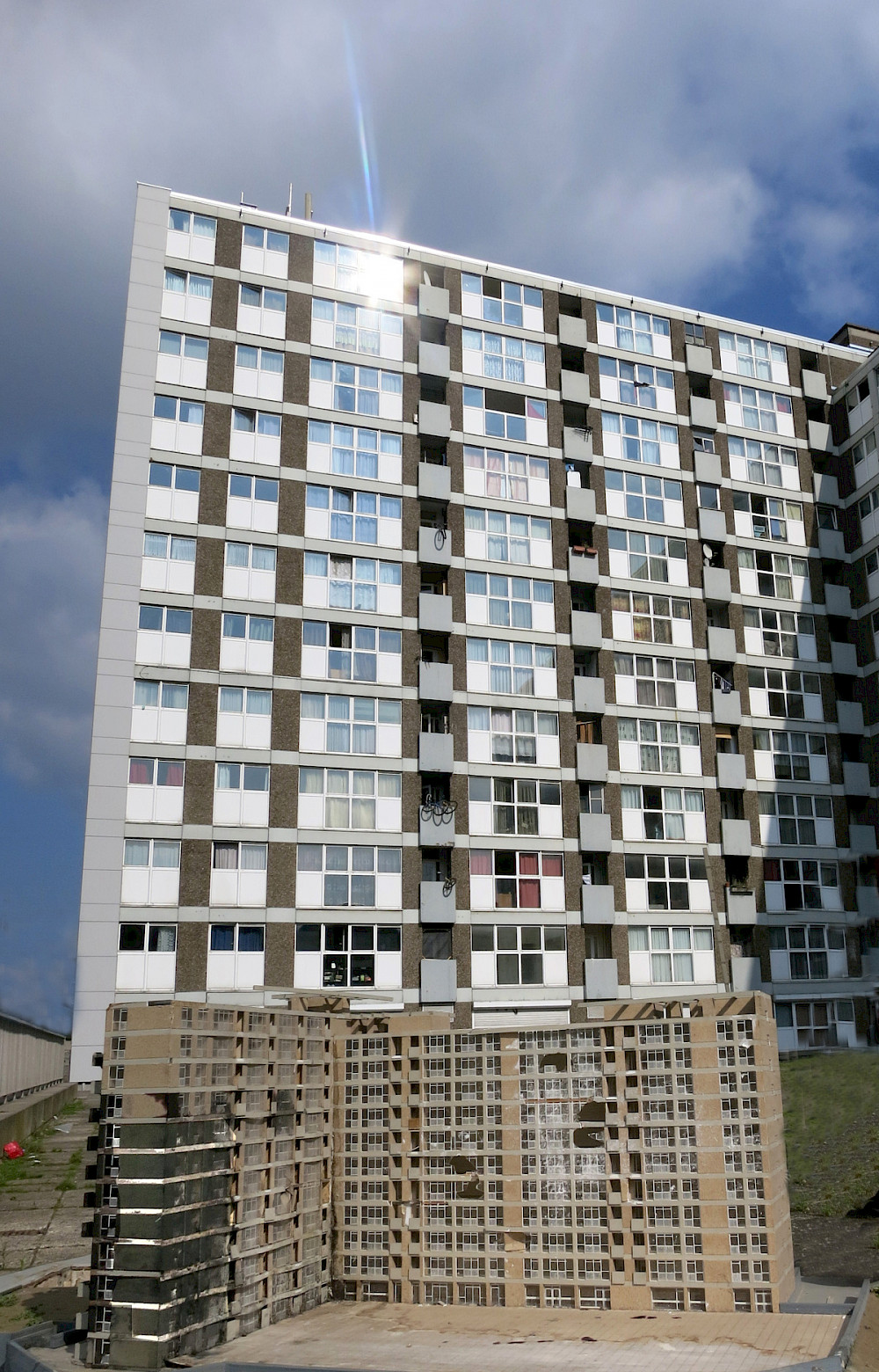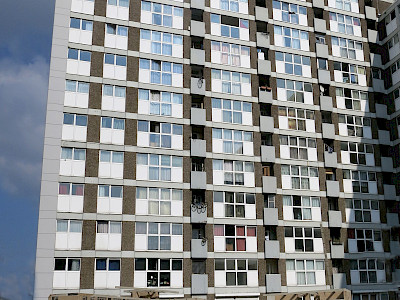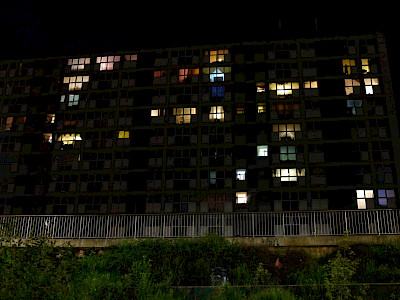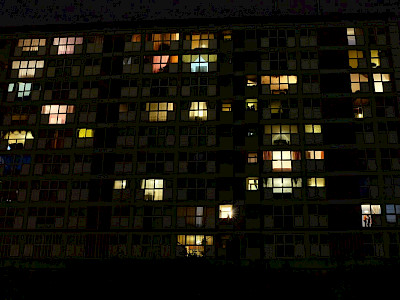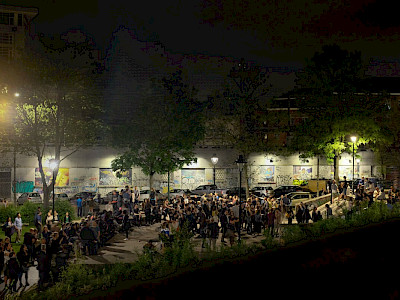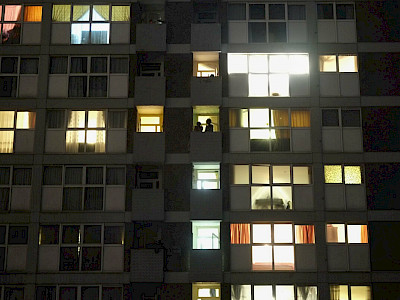07.05.2016
Anna Rispoli Brussels
Vorrei tanto tornare a casa ancora una volta (2009-2016 Rémolition)
performance
The first episode of the performance Vorrei tanto tornare a casa premiered in the Marolles in 2009 with the assistance of residents of the Brigittines-Visitandines estate. The domestic light show transformed the windows of a high-rise block of flats into instruments in an orchestra of light operated by the residents themselves. It questioned our ability to live together in the density of major urban centres. Seven years on, this public work of art is now being recreated or, as the architect Lucien Kroll would say, it is being “remolished”: revisited, enhanced by the complexity of the hundreds of stories that have gone into it. How has Brussels changed during these seven years? How has our view of the city changed? What are the challenges posed by cohabitation today? To what extent does an ephemeral work of art leave traces in a community’s imagination? According to Anna Rispoli: “At this time of crisis, it seems more important than ever to return to the possibility of being confronted with difference and the utopia of cohabitation”.
See also
After talk with Daniel Blanga-Gubbay
8/05 – 18:00 (Les Brigittines, Aquarium)
Vorrei tanto tornare a casa ancora una volta
Going into Jan’s place, you would think you were in a botanical garden. Hundreds of plants fight to get enough light from the only window and cast verdant shadows across the shelves of experimental rock albums from the 1970s and erotic comic books. “The essence of life: fesses etfeuilles,” says Jan laughing, “but no one understands that here, because with the new International Monotheistic Front, they have all become prudes. Me, I don’t give a damn, I’ve already escaped death once, so no one will stop me from having a laugh anymore.”
Mrs Moreno has lived here since the building was new in 1974. She shows me photos of her dog. “It used to be a first-rate building, with lifts and hot water. I knew everyone before, until the Arabs arrived. Now, you can’t go out on the landing without your neighbours stealing from your home. Immigration is to blame,” she says, lost in thought, perhaps forgetting the time she arrived from Spain by bus.
On the 4th floor, no one ever replies. Behind the door, a dripping sound can be heard. Perhaps the Foyer forgot to tell me that this flat is empty. After the sixth or seventh time I rang on the doorbell, a very old Vietnamese man opens the door. He does not really understand what I’m talking about. “An artist? You mean the plumber from the CPAS? Have you come about the damp stains? Then, come, please come in.” Inside it’s pitch dark and empty, only a small torch lights a corner of the table. In this damp atmosphere, the outlines of the walls disappear. I pick out someone sitting in a corner, a girl. She’s there, busy sewing, and doesn’t utter a word. Water continues to drip from the wall.
I pace along the endless windowless corridors, punctuated by fire doors and lit by flickering neon, and I think about the report from the social worker who, when referring to the disconnected set of individuals and families who live in the building, nevertheless speaks of a “community of residents”.
The first time I entered the Moustars’ flat, the lady of the house immediately offered me slippers. Their two-room flat with a kitchen is like a sweetshop: the sofas look like sweeties, wrapped in cellophane (which, I imagine, is removed when relatives come to visit), the chandelier with hanging droplets, the pink wallpaper, the twins in matching outfits. It’s hard to believe that, one night, Mrs Moustar, exasperated by the noise from the family on the floor below, after banging on the gas pipes to protest, got up, made the neighbour open the door and then poked her in the eye with the heel of a shoe.
The 11 floors of the Brigittines-Visitandines tower block house 143 parallel universes, stacked in a space managed by the Foyer Bruxellois. As I try to find my way through the labyrinth of staircases, I get the impression that “community” in this high-rise, hurriedly constructed with a ten-year projected life following the demolition of the Jonction, is more of a goal to strive for in future.
Excluded from the groups that decide about the organisation of the space and what it looks like, this potential community could, however, lay claim to their knowledge of experience of coming up against the regulatory frameworks imposed by urban planners.
Try to intensively perceive the other, despite your frustrating claim for isolation. Imagine a neighbour moving in the room next door, walking above or below, touching the walls that separate you while carrying out household chores, setting in motion diabolical electrical devices of an unlikely machine for living, celebrating domestic technologies that should acknowledge the democratisation of humans’ control over the environment: now the light will turn on, the water will come out of the tap, now it will be warmer, you will finally be all alone.
The bitter-sweet emotion with which we consider the unlikely control over our destinies today tells us more about an adult reawakening of the urban vision – in which both conflict and co-operation form part of the experience of living together – than about the failure of the modernist dream of progress (as if living together should resemble a kind of harmonious, North Korean choreography).
One day in 2008, I imagined that this social conglomerate could use its silent presence, its “active non-participation”, to put on an act of disobedient insubordination against the order of things. With the collusion of residents of the Foyer Bruxellois Brigittines-Visitandines, the first episode in the architectural performance Vorrei tanto tornare a casa (I’d really like to go home and hope the lift is working) premiered in May 2009.
Since then, several activities have taken place in and around the building but also in the residents’ minds. These include the creation of the building’s residents’ association, the urban vegetable garden on the paved area, plantations, the Aquarium, Marollywood, the opening of the Brigittines gardens to residents, the battle won to have a case worker paid for by the Foyer, lift repair, the closure of fire escapes taken over by gangs, the mobilisation of adults and children against the project that wanted to turn their playground into an underground car park, but also the disasters of Zaventem, Maelbeek and the bashing of Molenbeek…
Francesca played one season in women’s football first division, Brahim acted in the film Black. Hakima, Yassine, Christine, Sofiane, Sirazo, Thierry, Ahmed, Esmeralda and Diego take people on short guided tours of the neighbourhood, Laurent said goodbye to us with a bottle hidden under his bed. Sam, the best ice-cream man in the world, opened his workshop on the ground floor of the block and Maria finally left her violent partner. The confident and generous Sudanese family still lives in the building, but who can say whether Youssef is going to manage to find work and whether Syria really played a role in Halima falling from the balcony… We learned the terrible news while we were undertaking our preparations, and with those affected eventually took the decision to carry on and to dedicate this ritual of transformation to her.
The architect Lucien Kroll would call it remolition: we’re not building on fresh ground but rather on a constantly changing complexity of ruins and living beings. Who can say whether a public work of art has the power to turn people into a society? It definitely won’t be enough, but there remains a certain obstinacy in imagining that the present is created by women, men, people who can quite simply switch off the TV, open the curtains, put on the lights all together and look at one another from the outside.
Above all, people who can demand a fairer, more fitting and richer look at what they have to offer the amalgamated media, repression by the police and communitarian attitudes.
The performance in 2016 is the same as the one in 2009. What has changed is the city around it, the people who live there, Brussels as a witness of two moments that are relatively close in time and yet already so different.
*This text is made up of excerpts from ‘In Media Res’, The Time We Share, 2015
A project by
Anna Rispoli
In collaboration with
Flore Grassiot/Marollywood
Assisted by
Mathilde Florica
In connection with
the inhabitants of Foyer Bruxellois Brigittines - Visitandines
Tuned car
Jonathan Wuyts - Team maximum spl
Media partner
Radio Campus 92.1
Thanks to
Tunix, Luce Goutelle, Jeanne Boute, Gaia Carabillo, Irena Radmanovic, Livia Cahn
Presentation
Kunstenfestivaldesarts, Les Brigittines
